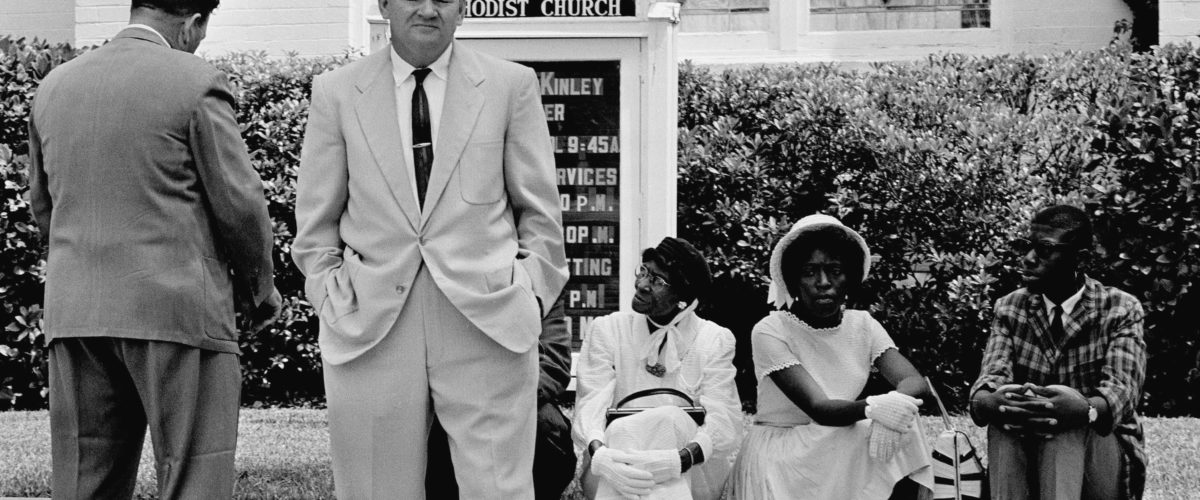In addition to Halloween yesterday, many in the Protestant Christian world celebrated Reformation Day, commemorating when Martin Luther posted his “95 Theses” on the door of the Castle Church in Wittenberg, Germany, Oct. 31, 1517. This is commonly understood as the precipitating event that led to the birth of Protestantism, the break from the Roman Catholic Church, which has produced, in the American context alone, about 200 denominations.
With Luther as a model in Christian circles, these schisms mostly are explained in theological terms. But I’ve been thinking back to a different understanding of denominationalism that casts important light on the racial reckoning we again are facing in this country, as well as the complicity of white Christian churches that paved the way.
 Nearly a century ago, H. Richard Niebuhr decried what he called “the social sources of denominationalism” in American Christianity. His book by that name challenged the internal church storyline that the proliferation of Protestant denominations was due to intra-church theological disputes. They often relied on competing scriptural proof-texts for legitimacy regarding issues like the proper method of baptism, the organization of the church, the understanding of distinctions between clergy and laity, the conception of and number of sacraments, and the use of instruments, icons and stained glass.
Nearly a century ago, H. Richard Niebuhr decried what he called “the social sources of denominationalism” in American Christianity. His book by that name challenged the internal church storyline that the proliferation of Protestant denominations was due to intra-church theological disputes. They often relied on competing scriptural proof-texts for legitimacy regarding issues like the proper method of baptism, the organization of the church, the understanding of distinctions between clergy and laity, the conception of and number of sacraments, and the use of instruments, icons and stained glass.
Niebuhr, however, argued these divisions primarily “have their roots in the relationship of the religious life to the cultural and political conditions prevailing in any group of Christians.” He sent a sharp warning to those who easily believe the stories Christians tell themselves about these splintering identities: “Only the purest novice in history will seek the explanation of such opinions in the proof-texts from which they purport to derive.”
The ’moral failure of Christianity’
Beyond a simple lack of Christian unity, Niebuhr argued these schisms reflected something much more scandalous. The “evils of denominationalism,” as he put it, lie in the fact the divisions were not just honest theological disagreements between Christians of good will, but rather the acquiescence of Christians and churches to the prevailing prejudices of the broader culture.
In a remarkable passage, Niebuhr lays out his indictment of this “moral failure of Christianity”:
Denominationalism in the Christian church is such an unacknowledged hypocrisy … . It represents the accommodation of Christianity to the caste-system of human society … . The division of the churches closely follows the division of men into the castes of national, racial, and economic groups. It draws the color line in the church of God; it fosters the misunderstandings, the self-exaltations, the hatreds of jingoistic nationalism by continuing in the body of Christ the spurious differences of provincial loyalties; it seats the rich and poor apart at the table of the Lord, where the fortunate may enjoy the bounty they have provided while the others feed upon the crusts their poverty affords.
Predictable denominational affiliations
Niebuhr’s indictment still hangs in the air a century later.
Even among white, non-Hispanic Christians, you still can, with considerable accuracy, predict denominational affiliation from variables like income and education levels alone. A friend related a true story that captures this reality. When he asked his father how they became Presbyterian, the answer came back: “Well, your grandfather was a Baptist. But he made enough money that we got to skip Methodist and go straight to Presbyterian.”
Growing up in our white working-class corner of Jackson, Miss. — even if we never articulated it that explicitly — we considered ourselves happily above the Pentecostals down the road, aspiringly competitive with the Methodists in our neighborhood, and resentfully below the Episcopalians across town, at least when we bothered to think about them.
Martin Luther King Jr.’s lament that 11 a.m. on Sunday morning is the most segregated hour in America remains largely true. Only 16 percent of America’s churches today are multi-racial churches. And there’s growing evidence, as I noted in a piece for Religion News Service this summer, that the few African Americans who ventured into white evangelical spaces are reconsidering after the unwavering support this group gave to a president whom a majority (57 percent) of Americans believe was encouraging white supremacist groups.
These racial divisions at church aren’t just incidental or voluntary because of cultural differences, as the story goes in white Christian circles.
These racial divisions at church aren’t just incidental or voluntary because of cultural differences, as the story goes in white Christian circles. Rather, the boundaries were policed with “whites-only” membership policies, city ordinances, and even deacons stationed on the front steps as bouncers, with sheriffs as enforcers, to prevent nonwhite people from entering the sanctuary.
The last campaign Medgar Evers led before being gunned down in his own driveway was an unsuccessful effort to integrate the white Christian churches of my hometown of Jackson, Miss. And the man who pulled the trigger? A white member in good standing of an Episcopalian church in the Delta.
Two opposite groups
In the academic world, the cultural and political differences among Christians by race and ethnicity remain so pronounced and stable that social scientists, including our research team at PRRI, regularly sort those who identify as Christian on surveys by both race and ethnicity so that their analysis matches the divisions in the real world.
In the religious landscape, no two groups have more opposite voting patterns and political attitudes than white evangelicals and African American Protestants, a majority of whom also consider themselves to be born again or evangelical. The AP Votecast 2020 presidential election exit poll, for example, showed 81 percent of white evangelicals voted for Donald Trump, while 92 percent of Black Protestants voted for Joe Biden. Notably, this is a wider gap than between white evangelicals and religiously unaffiliated Americans.
Even the term “evangelical” — the English translation of a Greek word in the New Testament literally meaning “good news” — is connected to different identities and values, depending on the race of the adherent. According to PRRI data from August, nine in 10 (90 percent ) of Black Protestants who identify as evangelical/born again hold unfavorable views of Trump, including more than seven in 10 who hold very unfavorable views of the former president. By contrast, white evangelical Protestants hold a favorable view of Trump by a two to one margin (66 percent favorable, 34 percent unfavorable). And it’s not just about Trump. White evangelical Protestants are more than twice as likely as Black evangelical Protestants to believe, for example, that “immigrants are invading our country and replacing our cultural and ethnic background” (50 percent vs. 22 percent).
“The problem of the 20th century is the problem of the color line.”
‘The color line’
Niebuhr’s 1929 reference to “the color line” drew on W.E.B. Dubois’ use of the term two decades earlier in The Souls of Black Folk. Looking back 60 years to the eclipse of the unrealized promise of Reconstruction and ahead to the dawning of a new century, DuBois declared, “The problem of the 20th century is the problem of the color line.”
While working on White Too Long, one devastating insight became clear to me: Given the cultural, political and moral power white Protestant Christianity has wielded in America, it was historically the institution most capable of, and most responsible for, ending slavery, segregation and other forms of racial discrimination and oppression.
If, at any time in our history, we white Protestant Christians had stood united with a clarion “No!” to white supremacy, the country could have taken a different course. We have yet to do so. Tragically, one hundred years on, the color line continues to be the problem of the 21st century. May we be the generation that stops this from being true for yet another century.
Robert P. Jones is CEO and founder of PRRI and the author of White Too Long: The Legacy of White Supremacy in American Christianity, which won a 2021 American Book Award.
This column originally appeared on Robert P. Jones’ substack #WhiteTooLong. In partnership with the author and PRRI, each Monday BNG will feature a new column from Jones.
Related articles:
What if your ‘Christian worldview’ is based on some sinful ideas? | Opinion by Jacob Alan Cook
The Color of Compromise: American Christianity’s legacy of racism calls for ‘repentance and repair’ | Opinion by Bill Leonard
The colors of America | Opinion by Michael Malloy



